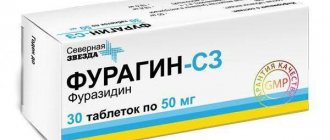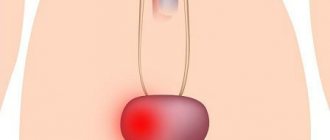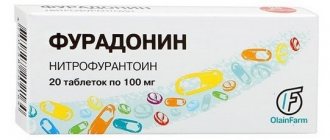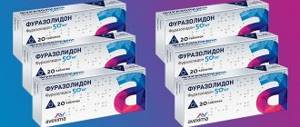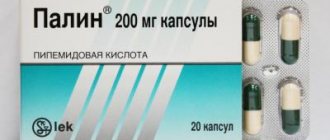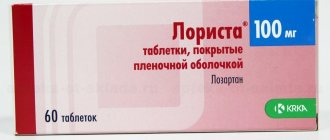Composition, release form and packaging
The drug Lespeflan is produced:
In the form of a liquid extract (solution) for oral administration, a liquid with a specific odor, from light brown (with a tinge of orange) to reddish-brown.
Active ingredients: 100 ml - 70.8 g of bicolor lespedeza shoots.
Additional components: anise oil, ethanol 95%, purified water.
The cardboard packaging contains 1 orange glass bottle with a capacity of 100 ml, sealed with a stopper, and a plastic cap on top.
Indications for use
Despite the fact that the medication contains only natural ingredients, it can also cause side effects, so you need to take it with extreme caution, carefully reading the instructions and studying the contraindications.
Experts warn that the use of Lespeflan should be abandoned in the following cases:
- if the woman is pregnant;
- when breastfeeding;
- age less than 18 years;
- presence of alcohol or drug addiction;
- individual hypersensitivity;
- tendency to allergic reactions (preliminary tests must be carried out).
If you ignore such contraindications and are treated with the drug, the likelihood of side effects will increase several times. Also, the risk of deterioration of the patient’s condition cannot be excluded.
As the instructions show, Lespeflan is used in the following cases:
- Combined treatment of diseases of the urinary tract;
- acute or chronic nephritis, accompanied by a sufficiently high level of nitrogen in the human blood;
- “permanent” renal failure of various origins.
Lespeflan should be taken orally, 10-15 ml 3-4 times daily for 4 weeks.
There are some instructions for using the drug. During treatment, it is important to remember that a large composition of alcohol causes drowsiness and therefore for some time it is preferable to avoid driving and activities that require concentration. If hyponatremia is detected, then another sodium solution is prescribed.
Lespeflan should not be taken during lactation, pregnancy or in case of intolerance to the drug.
It is also contraindicated for children under 18, with brain diseases, and traumatic brain injuries. This drug should not be used by patients with alcohol dependence and in cases of high sensitivity or intolerance to the components of the drug.
Lespeflan is used in the treatment of kidney failure. Lespedeza sprouts contained in the composition eliminate toxins. The preparation contains flavonoids - quercetin, kaempferol, lespedin, eriodictyol and isoquercitrin, alkaloid, vitamin C, microelements such as boron, zinc, selenium, aluminum and manganese, saponins and tannins.
In addition to the treatment of kidney inflammation, which is accompanied by chronic failure, the medicine is effective in pyelonephritis, urolithiasis and glomerulonephritis.
The product has a powerful immunomodulatory effect and the ability to have a stabilizing effect on water-salt metabolism. When using the drug Lespeflan, excellent changes are observed:
- Sodium is eliminated faster;
- azotemia decreases;
- nitrogenous wastes are better removed;
- increased diuresis.
Lespeflan does not interact with medications that have a severe effect on the nervous system. The use of the drug is incompatible with taking oral hypoglycemic drugs or insulin. Cannot be used for diabetes mellitus. Lespeflan is not used with furazolidone, metronidazole and ceftriaxone. If treatment with metronidazole is prescribed, then three days before treatment, use of the drug lespeflan should be discontinued.
In the life of any person, the kidneys carry out a great job; they cleanse the human body of toxins and harmful substances. When they stop functioning well, it affects all organs.
Today medicine presents many drugs whose action is characterized by a restorative effect. Lespeflan is a natural product.
It has a less “rough” effect on the human body.
The drug Lespeflan belongs to the pharmacological category of drugs. It is used to heal “sick kidneys”. in the composition of plant substances it has a mild beneficial effect. Most often, it does not have “third-party” effects.
The specific composition of the drug, especially the presence of the active component of Lespedeza shoots, ensures the operation of the “mechanism”. During the process of penetration into the body, urination increases, filtration in the glomeruli of the kidneys increases, and, consequently, the concentration of uric acid creatinine decreases, potassium and sodium salts “leave out.”
The drug also has an anti-inflammatory effect. As practice shows, Lespeflan is considered a fairly effective medicine. This is confirmed by positive reviews from clients who say that their health has improved. However, there is one negative factor.
This presence of a large percentage of ethyl alcohol affects driving and has a bad effect on kidney disease.
At the beginning of treatment, it is necessary to consult a doctor, because only a qualified doctor can give an objective assessment of the patient’s health and prescribe the required dosage of the drug. This drug is used internally.
Lespeflane is first diluted with water and taken 3-4 times a day. A one-time dose of the drug is represented by a dosage of 10-15 ml of a teaspoon or a tablespoon. The maximum dose taken per day can be 100 ml.
The medicine must be used in a course, the duration of treatment is up to 4 weeks, but in an individual case the doctor can extend the treatment up to 6 weeks. If necessary, the course of treatment can be repeated, but not earlier than 2 weeks after treatment.
Most of the “clients” are concerned that the medicine can lead to alcohol dependence. However, if the dosage is chosen correctly, everything will be fine, and if used intravenously, no adverse reactions will occur.
The drug is used as part of complex therapy for chronic renal failure of various origins in latent, compensated and intermittent stages.
- Alcoholism;
- Liver diseases;
- Brain diseases;
- Traumatic brain injuries;
- Age up to 18 years;
- Pregnancy;
- Lactation;
- Hypersensitivity to components.
We invite you to read: The cat chooses its owner. By what principle does a cat choose its owner? How a cat chooses its owner: the cat’s attachment to a person
Complex therapy:
- diseases of the urinary tract;
- nephritis (acute, chronic form);
- chronic renal failure;
- hyperazotemia.
pharmachologic effect
Hypoazotemic remedy. Strengthens glomerular filtration, actively increases the clearance of creatinine, uric acid, urea.
A decrease in the level of nitrogen metabolism products is noted during treatment.
When using Lespeflan, a moderate diuretic effect is observed.
Lespeflan has an anti-inflammatory effect.
The chemical composition of the shoots of two-color lespedeza contains a complex of biologically active components, thanks to which the correction of all metabolic processes is carried out in the human body.
Lespeflan, thanks to its plant base, helps cleanse the body of metabolic products and eliminate toxins.
The plant shoots contain: flavonoids (eriodictyol, quercetin, isoquercitrin, kaempferol, lespedin), alkaloid, saponins, tannins, ascorbic acid, trace elements (boron, zinc, potassium, aluminum, selenium).
Lespeflan is endowed with an immunomodulatory effect and stabilizes water-salt metabolism. By washing away potassium, it does not irritate the renal system and is low-toxic.
Features of the product's action
The medication is widely used as a method of treating pathologies of the urinary organs that are inflammatory in nature. It is also effective in chronic renal failure. In addition, patients with diseases such as pyelonephritis, glomerulonephritis and urolithiasis are often prescribed Lespeflan. The instructions indicate that the product helps normalize water-salt metabolism.
It is not highly toxic and non-irritating. After the course of therapy, positive dynamics in the patient’s condition are observed. The amount of urine excreted increases, kidney function stabilizes, and the body is freed from excess amounts of nitrogen compounds and sodium. A good effect can be achieved if you carefully read the instructions for use before using Lespeflan. Analogues of this medicine are the following drugs:
- "Ornithine."
- "Lespenephril."
- "Flaronin"
- "Ornitsetil".
Side effects
The basis for side effects when using Lespeflan is the high ethanol content (3-12 g of alcohol when calculating the dose per day).
In rare cases, the following side effects have been observed:
- arrhythmias;
- increased drowsiness;
- on psychomotor reactions - slow response;
- cardiopalmus.
Since when using Lespeflan, sodium is washed out of the body, therefore, it is possible for this reason that there is severe weakness and dizziness, which in turn are the first signs of hyponatremia, which can be confirmed by special laboratory tests.
In what cases is it undesirable to use the medication?
In conjunction with other drugs, the drug “Lespeflan” is used to treat pathologies of the urinary system. Instructions for use and reviews from experts indicate that it should be used only for those diseases that are associated with an increase in the concentration of nitrogen compounds in the blood.
There are several conditions in which the use of medication is prohibited. These include the following:
- The patient's age is under 18 years.
- The period of breastfeeding and gestation. It is undesirable to take the medicine due to the fact that it contains ethyl alcohol.
- Mechanical head injuries.
- Brain pathologies.
- Alcohol addiction.
- Individual intolerance to the components used in the manufacture of the drug.
- Various liver diseases.
Since the product contains ethyl alcohol, it is prohibited to drive vehicles during the course of therapy. In addition, for the same reason, it is undesirable to perform work activities that require high concentration and quick reaction.
special instructions
Since Lespeflan is of plant origin, during its storage it is possible to form a light sediment that does not affect the effectiveness of the drug.
If hyponatremia develops, it is recommended to administer sodium supplements.
The maximum daily dose of the extract (corresponding to 15 ml) contains 18.9 g of absolute alcohol, which may lead to a decrease in the rate of reactions. This fact should be taken into account when using Lespeflan, since this is very important when driving complex mechanisms and vehicles.
Overdose
Lespeflan solution should be taken orally, 5-15 ml (1 teaspoon-1 tablespoon) 3-4 times a day. If necessary, immediately before use, the product can be diluted with water.
The duration of treatment is 3-4 weeks. If prescribed by a doctor, a second course is possible after 2-3 weeks.
An overdose can be caused by the ethyl alcohol contained in the drug.
Symptomatic treatment of alcohol intoxication is recommended.
This domestically produced drug is an aqueous-alcoholic solution of a purified extract obtained from the leaves (shoots) and stems of Lespedeza bicolor (Lespedeza bicolor). Latin name of the drug: Lespeflan.
The drug is available in 100 ml orange glass bottles. Externally, Lespeflane is a light brown liquid with an orange tint and has a specific odor.
Lespedeza bicolor shoots contain saponins, tannins, alkaloids, flavonoids (kaempferol, isoquercitrin, lespedin, eriodictyol, quercetin), trace elements (zinc, aluminum, potassium, selenium, boron).
| Substance name | Quantity |
| Ethanol | 1210 ml |
| Purified water | 680 ml |
| Lespedeza bicolor shoots | 708 g |
| Anise oil | 0.7 g |
This drug is classified as a hypoazotemic drug. It increases the clearance of uric acid, urea and creatinine, and also enhances glomerular filtration.
When treated with it, a decrease in the level of nitrogen metabolism products is noted.
In addition, Lespeflan has a pronounced diuretic (diuretic) effect, has an anti-inflammatory and immunomodulatory effect, and when used in the body, water-salt metabolism is stabilized.
The drug based on bicolor lespedeza contains biologically active components that help correct all metabolic processes in the body. As a result of the use of the medicine, toxins are eliminated and metabolic products are cleansed.
The medicine is low toxic, promotes the release of sodium and potassium.
According to the instructions, the herbal medicine is recommended for use by adults suffering from certain diseases. These include:
- Chronic intermittent renal failure accompanied by azotemia.
- Chronic and acute nephritis of various origins, which occurs with an increased level of nitrogen in the blood.
The drug must be shaken before use. Directions for use: inside. According to the instructions, it is permissible to dilute the medicine with water immediately before use. The course of treatment is 3-4 weeks.
Repeated use of the drug is allowed after a 2-week break. Lespeflan - with instructions for use, it is recommended to use 5-15 ml (1 tsp - 1 tbsp) 3-4 times a day.
It is possible to increase the daily dose to 80-100 ml and extend the course of treatment to 6 weeks.
special instructions
If hyponatremia develops, it must be compensated by administering sodium drugs.
The maximum daily dose of the drug contains 18.9 g of absolute alcohol, so a person’s speed of psychomotor reactions may decrease, which should be taken into account by those who drive vehicles and people working in places where concentration and speed of psychomotor reactions are required.
Lespeflan is a drug containing an extract of the lespedeza plant. This solution based on water and ethyl medical alcohol can have a diuretic effect on the human body. It has properties that help patients with chronic circulatory failure.
Trade name of the drug: Lespeflan®
Dosage form: oral solution
Photo of lespeflan solution showing the composition
Active substance: lespedeza two-color shoots (lespedeza two-color shoots) - 555.5 ml. Excipients: ethanol (ethyl alcohol) 95% - to obtain 555.5 ml of extract, anise oil - 0.55 g, gelatin - 5.5 g , treated water - up to 1 liter.
Description
Liquid from light brown with orange to reddish-brown color with a specific odor; Precipitation may occur during storage.
Pharmacotherapeutic group: hypoazotemic agent of plant origin
ATX code:
However, as a negative factor, the high content of ethyl alcohol in Lespeflan is noted, which not only imposes certain restrictions on everyday activities (for example, driving a vehicle), but can also negatively affect the already impaired kidney health.
Lespeflan is available in the form of a light brown solution (extract) for oral administration. The drug has a specific smell. Sold in dark bottles with a capacity of 100 ml.
The drug contains the following components:
- Shoots (stems and leaves) of Lespedeza bicolor (70.8 grams per 100 ml of product);
- Anise oil;
- Ethyl alcohol (95%);
- Purified water.
Lespeflan is a herbal preparation that is obtained from the shoots of Lespedeza bicolor. The drug has a diuretic effect.
It increases the rate of glomerular filtration, reduces the content of nitrogen metabolic products in the body, and increases the excretion of urea, creatinine and uric acid from the body.
Lespeflan can only be prescribed to adult patients, with the exception of pregnant women and breastfeeding women.
Dosage form
The medicine is available in the form of an oral solution.
Description and composition
The medication is a liquid with a characteristic odor, the color of which can vary from light brown with an orange tint to reddish brown. During storage, sediment may form.
As an active ingredient, the drug contains shoots of Lespedeza bicolor.
In addition, the medication contains the following additional substances:
- ethanol;
- anise oil;
- gelatin;
- purified water.
The biologically active components that make up the drug reduce renal filtration, reduce the level of nitrogen in the blood, increase the excretion of nitrogenous wastes in the urine and diuresis, increase the excretion of sodium from the body and, to a lesser extent, potassium.
for adults
Lespeflan is used in combination with other medications for symptomatic treatment as a hypoazotemic and diuretic for chronic renal failure of various origins in the latent, compensated and intermittent period.
for children
The drug is not used in patients under 18 years of age, since it contains ethanol and there is not enough experience in treating minors.
Lespeflan should not be taken by women who are expecting a baby or who are breastfeeding, as the drug contains ethanol, and it can have a negative effect on the fetus and breastfed infant.
Due to the ethanol content, it is not recommended to drink the medicine to patients who receive:
- medications that depress the central nervous system;
- hypoglycemic agents such as insulin, metformin, sulfonylurea derivatives;
- medications that provoke intolerance to ethyl alcohol (disulfiram-like reactions, such as nausea, vomiting, palpitations, redness of the skin).
Overdose
If the recommended doses are exceeded, signs of overdose may appear, provoked by the ethyl alcohol included in the medication.
In this case, medications are prescribed to eliminate the symptoms of alcohol intoxication.
Storage conditions
Lespeflan is produced by several companies, so storage conditions and shelf life of the medication may vary.
Negative action
Side effects are caused by individual sensitivity to Lespeflan, the presence of chronic diseases incompatible with its use, and violation of the rules for taking and storing the drug.
Hyponatremia
This is a condition in which the level of Na (sodium) in the blood plasma becomes less than 135 mmol/l. The clinical picture of complications is dominated by neuropsychiatric disorders: nausea, drowsiness, imbalance. Vascular tone and contractile function of the myocardium decrease—the heart rate increases, and dizziness may occur.
If long-term treatment with Lespeflan is necessary, laboratory monitoring of sodium and potassium levels in the blood is carried out. The issue of duration and termination of therapy is decided individually.
Disulfiram-like effect
A disulfiram-like reaction to the use of Lespeflan can be expressed in the appearance of chills, severe headache, nausea and vomiting, dystonia (usually a decrease in blood pressure), bradycardia, difficulty breathing, loss of coordination, dizziness, loss of consciousness.
Similar reactions occur in patients with chronic alcoholism, for which disulfiram was used for coding, when the treatment regimen is violated. The average daily volume of Lespeflan used contains from 3.0 to 11.5 g of 95% ethanol. When taking the solution, you must avoid drinking alcoholic beverages.
Decreased alertness
A similar reaction is also associated with the presence of 95% ethanol in Lespeflan. This should be taken into account during active production activities and driving vehicles.
Individual intolerance
Lespeflan should be stopped immediately if an allergy occurs. It is imperative to consult a doctor.
Instructions for use
Lespeflan is used daily orally before meals, after diluting it with boiled water at room temperature. Shake the bottle of solution before use. Lespeflane is usually taken 3 to 4 times a day. For one dose, you should use from 5 ml (1 tsp) to 15 ml (1 tbsp) of Lespeflan. The maximum daily dose of the drug is 100 ml.
The standard of treatment determines the duration of the first course at 3 - 4 weeks. Under laboratory control of determining Na (sodium) in the blood, the doctor decides to extend treatment for another 2 weeks. Then there must be a break of 14 days, after which the course can be repeated.
For long-term use, Lespeflan is used in the minimum allowable dose (5 ml) once in the morning for 15 days in a row with a two-week break. If symptoms of hyponatremia appear, you should immediately seek medical help.
Drug interactions
Lespeflan is not prescribed in combination with medications that have a depressant effect on the nervous system, since the drug can enhance their effect. In addition, ethanol-containing liquid is incompatible with taking oral hypoglycemic agents and/or insulin. For this reason, people with diabetes should not take Lespeflan.
Taking this extract together with medications that can cause a disulfiram-like reaction is fraught with extremely unpleasant consequences. Medications such as ceftriaxone, metronidazole, furazolidone and others are incompatible with alcohol. If their use becomes necessary, treatment with Lispeflan should be discontinued at least 3 days in advance.
Mode of application
Lespeflan is recommended to be taken orally before meals. The extract can be diluted with ordinary drinking water without flavoring additives. The average daily dosage of the drug is 5-10 milliliters, that is, approximately one full teaspoon or tablespoon. And the maximum daily dose should not exceed 15 milliliters per adult. Lespeflan should be taken at least three times a day.
The standard course of treatment rarely exceeds four weeks, but in exceptional cases, doctors prescribe Lespeflan for six weeks.
In this case, it is introduced into the body either intravenously or intramuscularly, which enhances the effectiveness of the course. With long-term use, the dosage of Lespeflan is reduced to 2.5-5 milligrams per dose. This limitation is due to the fact that Lespeflan can lead to a critical lack of sodium in the patient’s body.
The liquid from the bottle is taken orally only. Depending on the type and stage of the disease, patients are prescribed from 5 to 15 ml. means 3-4 times a day.
Most doctors recommend taking the medicine not in its pure form, but adding the required amount to 200 ml. water, stir and drink.
To ensure that the product is properly absorbed by the body, it is recommended to take it before meals.
In rare cases, if the disease is difficult to treat, or the disease was detected at a late stage, the doctor may increase the dosage to 70-80 ml. The standard course lasts 3-4 weeks (maximum duration of therapy 42 days).
If necessary, the course can be repeated after maintaining an interval of 21 days.
After therapy, it is recommended to transfer the patient to maintenance treatment, which will help prevent deterioration and progression of the disease. To do this, it is enough to take 15 ml of the product. 1 time a day (in the morning).
Numerous clinical studies have confirmed that the drug can negatively affect the condition of the expectant mother and cause some complications in the fetus, so doctors strictly prohibit taking the drug during pregnancy and breastfeeding.
To choose a medicine against urological pathology, you need to consult with a doctor who will select an analogue, taking into account the individual characteristics of the patient and the duration of pregnancy.
READ Poisonous plants for cats - what are they?
For children
Lespeflan is not prescribed for children and adolescents under 18 years of age.
If a person independently increases the dosage of the drug and adheres to this treatment regimen for several days, signs of an overdose may soon appear.
Experts assure that the manifestation of symptoms is similar to ordinary alcohol intoxication; most patients complain of disorders:
- the occurrence of frequent dizziness;
- severe headache;
- nausea and vomiting;
- hand tremors;
- increased sweating.
If such symptoms occur, you must immediately call a team of doctors who will help relieve the symptoms.
Lespeflan solution should be taken orally, 5-15 ml (1 teaspoon-1 tablespoon) 3-4 times a day. If necessary, immediately before use, the product can be diluted with water.
The duration of treatment is 3-4 weeks. If prescribed by a doctor, a second course is possible after 2-3 weeks.
An overdose can be caused by the ethyl alcohol contained in the drug.
Symptomatic treatment of alcohol intoxication is recommended.
At the beginning of treatment, it is necessary to consult a doctor, because only a qualified doctor can give an objective assessment of the patient’s health and prescribe the required dosage of the drug. This drug is used internally. Lespeflane is first diluted with water and taken 3-4 times a day.
A one-time dose of the drug is represented by a dosage of 10-15 ml of a teaspoon or a tablespoon. The maximum dose taken per day can be 100 ml. The medicine must be used in a course, the duration of treatment is up to 4 weeks, but in an individual case the doctor can extend the treatment up to 6 weeks.
This domestically produced drug is an aqueous-alcoholic solution of a purified extract obtained from the leaves (shoots) and stems of Lespedeza bicolor (Lespedeza bicolor). Latin name of the drug: Lespeflan.
The drug is available in 100 ml orange glass bottles. Externally, Lespeflane is a light brown liquid with an orange tint and has a specific odor.
Lespedeza bicolor shoots contain saponins, tannins, alkaloids, flavonoids (kaempferol, isoquercitrin, lespedin, eriodictyol, quercetin), trace elements (zinc, aluminum, potassium, selenium, boron).
| Substance name | Quantity |
| Ethanol | 1210 ml |
| Purified water | 680 ml |
| Lespedeza bicolor shoots | 708 g |
| Anise oil | 0.7 g |
This drug is classified as a hypoazotemic drug. It increases the clearance of uric acid, urea and creatinine, and also enhances glomerular filtration.
When treated with it, a decrease in the level of nitrogen metabolism products is noted.
In addition, Lespeflan has a pronounced diuretic (diuretic) effect, has an anti-inflammatory and immunomodulatory effect, and when used in the body, water-salt metabolism is stabilized.
The drug based on bicolor lespedeza contains biologically active components that help correct all metabolic processes in the body. As a result of the use of the medicine, toxins are eliminated and metabolic products are cleansed.
Lespeflan is recommended for hyperazotemia because it reduces its severity. In addition, the drug is able to enhance renal filtration, diuresis, stimulate nitrogenous waste elimination and sodium (Na) excretion.
The medicine is low toxic, promotes the release of sodium and potassium.
According to the instructions, the herbal medicine is recommended for use by adults suffering from certain diseases. These include:
- Chronic intermittent renal failure accompanied by azotemia.
- Chronic and acute nephritis of various origins, which occurs with an increased level of nitrogen in the blood.
The drug must be shaken before use. Directions for use: inside. According to the instructions, it is permissible to dilute the medicine with water immediately before use. The course of treatment is 3-4 weeks.
Repeated use of the drug is allowed after a 2-week break. Lespeflan - with instructions for use, it is recommended to use 5-15 ml (1 tsp - 1 tbsp) 3-4 times a day.
It is possible to increase the daily dose to 80-100 ml and extend the course of treatment to 6 weeks.
special instructions
If hyponatremia develops, it must be compensated by administering sodium drugs.
The maximum daily dose of the drug contains 18.9 g of absolute alcohol, so a person’s speed of psychomotor reactions may decrease, which should be taken into account by those who drive vehicles and people working in places where concentration and speed of psychomotor reactions are required.
Lespeflan is a drug containing an extract of the lespedeza plant. This solution based on water and ethyl medical alcohol can have a diuretic effect on the human body. It has properties that help patients with chronic circulatory failure.
Trade name of the drug: Lespeflan®
Dosage form: oral solution
Photo of lespeflan solution showing the composition
Active substance: lespedeza two-color shoots (lespedeza two-color shoots) - 555.5 ml. Excipients: ethanol (ethyl alcohol) 95% - to obtain 555.5 ml of extract, anise oil - 0.55 g, gelatin - 5.5 g , treated water - up to 1 liter.
Description
Liquid from light brown with orange to reddish-brown color with a specific odor; Precipitation may occur during storage.
Pharmacotherapeutic group: hypoazotemic agent of plant origin
ATX code: [G04BX]
The complex of biologically active substances included in the drug Lespeflan® helps to increase renal filtration, reduces azotemia, increases the excretion of nitrogenous wastes in the urine, increases diuresis, increases the excretion of sodium and, to a lesser extent, potassium.
Every day and throughout a person’s life, the kidneys perform a huge amount of work, cleansing our body of harmful and toxic substances.
And when their normal functioning is disrupted, it negatively affects the functioning of almost all organ systems.
Therefore, modern medicine offers a lot of medicines whose action is aimed at restoring kidney function.
Natural preparations that have a less harsh effect on the body deserve special attention. One such remedy is Lespeflane.
Lespeflan is a drug that belongs to the pharmacological group of hypoazotemic drugs of plant origin. This extract is usually used to treat various kidney diseases.
The composition of the drug is predominantly herbal, which determines not only its medicinal properties, but also its mild, gentle effect.
Lespeflan practically does not cause side effects, which makes it stand out among its analogues.
Features of the composition of the drug, namely its active component - shoots of Lespedeza bicolor, determine the mechanism of its action.
Once in the body, Lespeflan
- increases urine output (diuresis),
- promotes increased filtration in the renal glomeruli, which reduces the concentration of nitrogen-containing metabolic products (creatinine, urea, uric acid) in the blood,
- removes sodium and potassium salts from the body,
- reduces blood cholesterol in patients suffering from atherosclerosis.
READ Beagle puppy training by month
Analogs
In addition to Lespeflan, the following analogues are available for sale:
- Lespefril is a domestic drug that is a complete analogue of Lespeflan. It is produced by ZAO Vifitech, Russia in the form of a solution for oral administration. The medication can be taken by persons over 18 years of age, with the exception of pregnant women and breastfeeding women.
- Lespedeza penny is a dietary supplement produced by. It is sold in herbs weighing 50 g, from which you can prepare infusions and decoctions. The dietary supplement is contraindicated for persons under 18 years of age, pregnant women and breastfeeding women.
- Lespenefril contains lespedeza capitate as an active ingredient. The drug is produced in the form of an alcohol solution, which is contraindicated for persons under 18 years of age, pregnant and lactating women.
- Tincture of Lespedeza kopeck produced in Ukraine, used in the same cases as Lespeflan. It is allowed to be taken only by adults. It is prohibited for pregnant and lactating women.
Taking an analogue instead of Lespeflan is permissible only after consultation with your doctor, since each medication has its own characteristics.
Description of the drug
In accordance with the RLS, Lespeflan is called an effective hypoazotemic and diuretic agent. The approximate price for a bottle of 100 milliliters is 147-229 rubles. The exact cost of the product depends on the region of purchase: the cost of Lespeflan is affected by the distance of the pharmacy from the place of production - the production enterprise "Pharmcenter VILAR" is located within the Moscow region.
The effect of the drug is due to the shoots of bicolor lespedeza from the legume family. This plant allows you to restore basic metabolic processes associated with the kidneys, but the functions of Lespeflane do not end there. Thanks to the correct use of the medication, it is possible to restore blood circulation or even treat acute nephritis.
Composition of Lespeflan
1000 milliliters of Lespeflan is created from 1210.0 milliliters of pure ethyl alcohol with a concentration of at least 95%, above-ground shoots of two-color lespedeza with a total weight of about 708.0 grams and anise oil with a volume of 0.7 grams. All components are diluted with 680.0 milliliters of purified water. The resulting extract is a slightly viscous light brown or orange syrup for oral administration with a specific, even repulsive odor.
Release form
The medicine is available in the form of an extract in an orange bottle with a plastic cap and stopper. It has a screw neck, and together with the double cap, it provides protection from children's pranks, as well as from the use of the product by people with permanent alcohol addiction.
The bottle is made of thick transparent plastic, packed in a cardboard box, and comes with detailed printed instructions. It is worth noting that during storage of the opened product outside the cardboard box, sediment may form at the bottom of the bottle. But it does not in any way affect the quality of the drug.
pharmachologic effect
Lespeflan, a hypoazotemic herbal remedy, is used to restore poorly functioning kidneys. It occurs due to the internal chemical reactions of the body to plant components, that is, to the shoots of two-colored lespedeza from the legume family, brought into a state of concentrated solution.
The presence of ethyl alcohol in the composition can lead to exacerbation of chronic kidney diseases.
When the product penetrates the human body, urination is activated, and filtration processes in the glomeruli of the kidneys are accelerated. Consequently, the concentration of uric acid decreases, and excess sodium and potassium salts are washed out.
In addition, the drug has an anti-inflammatory effect due to the high concentration of ethyl alcohol.
This Russian-made medicine helps reduce the risk of infection affecting the internal organs of the excretory system. Among the disadvantages of the pharmacological action of the drug, it is noted that the creatinine level decreases within 30 days. This significantly slows down the patient’s recovery process.
Expiration date and storage rules
Lespephlan syrup can be stored for no more than four years from the date of spilling. In this case, the medicine should not be exposed to direct sunlight, and the ambient temperature cannot exceed 25 degrees Celsius. Using the product after the expiration date indicated on the packaging and bottle, or if storage rules are not followed, can lead to severe poisoning or death.
Analogs
Lespeflan is a herbal medicine that has several analogues. The most famous are:
- Lespenefril is a French drug, the analogue of which at one time was the domestic Lespeflan. The basis of Lespenefril is Lespedesa capitata. This medicine is somewhat more effective than its Russian prototype, so it needs to be taken in smaller doses. According to the instructions, both extracts have the same indications, side effects and contraindications. The drug is available in the form of an aqueous-alcohol solution for oral administration and in injection form in ampoules along with a solvent. Lespenefril price in Moscow from 200 rubles.
- Lespefril is a complete analogue of Lespeflan - a 95% aqueous-alcohol solution made on the basis of lespedeza bicolor with the addition of a small amount of anise oil. According to the instructions, Lespefril has the same indications for use, contraindications and side effects. The price of the medicine is slightly lower - starts from 80 rubles.
- Flaronin is a herbal preparation available in tablet form. An analogue of Lespeflan is produced on the basis of a mixture of biologically active substances from the group of flavonoids extracted from the flowers and leaves of Astragalus sicklefruit. The medicine can increase diuresis, reduce the level of nitrogen in the blood, uric acid, and reduce inflammatory reactions, therefore it has the same indications as Lespeflan. Adverse reactions from taking Flaronin: allergies, hypoazotemia.
- Ornithine is one of the analogues that has a hypoazotemic effect, due to which the content of free ammonia in the blood plasma is reduced. According to the instructions, the indications for the use of Ornithine are hepatitis, liver failure, hepatic encephalopathy, liver damage of alcohol origin, liver cirrhosis, hyperammonemia. The medication is available in the form of a solution for injection, lyophilized powder for injection, and granulate for internal use, 3 g each.
- Ornitsethyl is a hypoammonemic drug whose active ingredient is ornithine. Like Lespeflan, this medicine is indicated for use in acute and chronic liver diseases, which are accompanied by hyperammonemia and hepatic encephalopathy. According to the instructions, the drug is contraindicated in cases of severe renal failure.
Lespeflan and Lespefril - differences
The Russian-made drug is an absolute analogue of the French one, therefore plant-based medicinal extracts have the same pharmacological effects, indications, contraindications and side effects. The difference between the medications is in price - the cost of Lespefril is slightly less, so the course of treatment for the patient will cost less.
Reviews of Lespeflan
Being a natural medicine based on herbal raw materials, Lespeflan, according to most patients, is effective in treating kidney diseases, supports the function of the urinary system, reduces the protein content in the urine, and prevents atherosclerosis of the kidney vessels.
Some users express dissatisfaction with the high alcohol content in the extract, unpleasant taste and burning sensation when taking the drug.
The medication is well tolerated and is often prescribed in urological practice for diseases of the renal system.
Terms and conditions of storage
The medicine can be used for the next 4 years after production. To ensure that the product does not lose its beneficial properties, the bottle must be stored closed at a temperature not exceeding 25 degrees. It is advisable that the bottle is in a dark place.
Store at temperatures up to 25 ºС in a place protected from light, out of reach of children.
Shelf life – 4 years.
Available without a prescription.
The approximate price of Lespeflan for a 100 ml bottle is 100–180 rubles.
It increases the rate of glomerular filtration, reduces the content of nitrogen metabolic products in the body, and increases the excretion of urea, creatinine and uric acid from the body.
Lespeflan can only be prescribed to adult patients, with the exception of pregnant women and breastfeeding women.
Dosage form
The medicine is available in the form of an oral solution.
Description and composition
The medication is a liquid with a characteristic odor, the color of which can vary from light brown with an orange tint to reddish brown. During storage, sediment may form.
As an active ingredient, the drug contains shoots of Lespedeza bicolor.
In addition, the medication contains the following additional substances:
- ethanol;
- anise oil;
- gelatin;
- purified water.
The biologically active components that make up the drug reduce renal filtration, reduce the level of nitrogen in the blood, increase the excretion of nitrogenous wastes in the urine and diuresis, increase the excretion of sodium from the body and, to a lesser extent, potassium.
for adults
Lespeflan is used in combination with other medications for symptomatic treatment as a hypoazotemic and diuretic for chronic renal failure of various origins in the latent, compensated and intermittent period.
for children
The drug is not used in patients under 18 years of age, since it contains ethanol and there is not enough experience in treating minors.
Lespeflan should not be taken by women who are expecting a baby or who are breastfeeding, as the drug contains ethanol, and it can have a negative effect on the fetus and breastfed infant.
Due to the ethanol content, it is not recommended to drink the medicine to patients who receive:
- medications that depress the central nervous system;
- hypoglycemic agents such as insulin, metformin, sulfonylurea derivatives;
- medications that provoke intolerance to ethyl alcohol (disulfiram-like reactions, such as nausea, vomiting, palpitations, redness of the skin).
Overdose
If the recommended doses are exceeded, signs of overdose may appear, provoked by the ethyl alcohol included in the medication.
In this case, medications are prescribed to eliminate the symptoms of alcohol intoxication.
Storage conditions
Lespeflan is produced by several companies, so storage conditions and shelf life of the medication may vary.
Thus, the solution of Dalkhimpharm OJSC Russia can be stored at a temperature of 15-25 degrees for 2 years from the date of production of the medicine.
The drug produced by Pharmcenter Vilar CJSC Russia must be stored in a dark place at a temperature of up to 25 degrees for 4 years from the date of release of the drug.
After the expiration date, Lespeflan cannot be taken; the medication must be disposed of.
It is necessary to ensure that during storage of the drug it cannot be reached by children.
You can buy the medicine without a prescription, but you cannot take it without first consulting a doctor, since only a doctor can make an accurate diagnosis and select an adequate dosage regimen for the drug.
The cost of Lespeflan is on average 209 rubles. Prices range from 71 to 373 rubles.
Danger of overdose
If a person independently increases the dosage of the drug and adheres to this treatment regimen for several days, signs of an overdose may soon appear.
Experts assure that the manifestation of symptoms is similar to ordinary alcohol intoxication; most patients complain of disorders:
- the occurrence of frequent dizziness;
- severe headache;
- nausea and vomiting;
- hand tremors;
- increased sweating.
If such symptoms occur, you must immediately call a team of doctors who will help relieve the symptoms.
